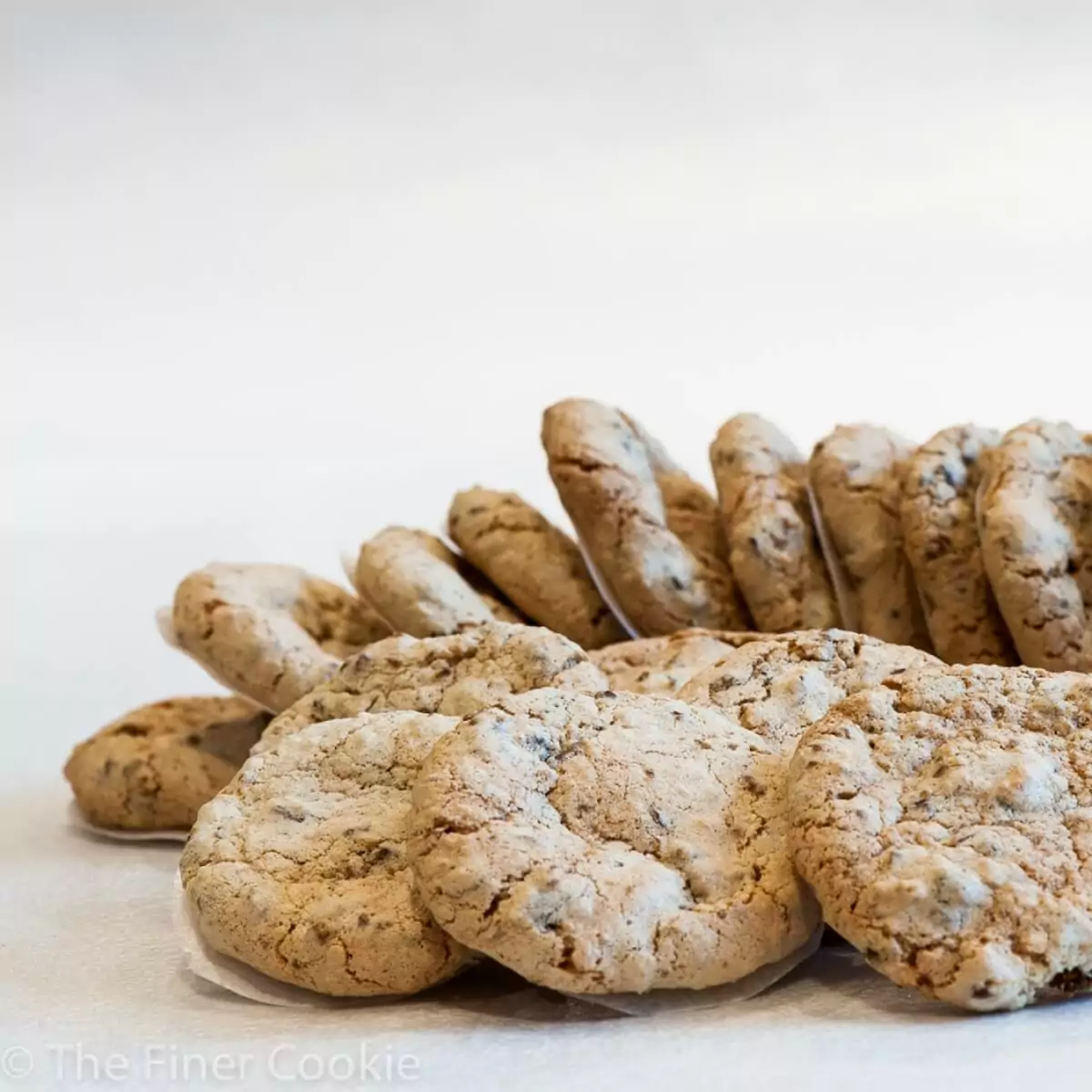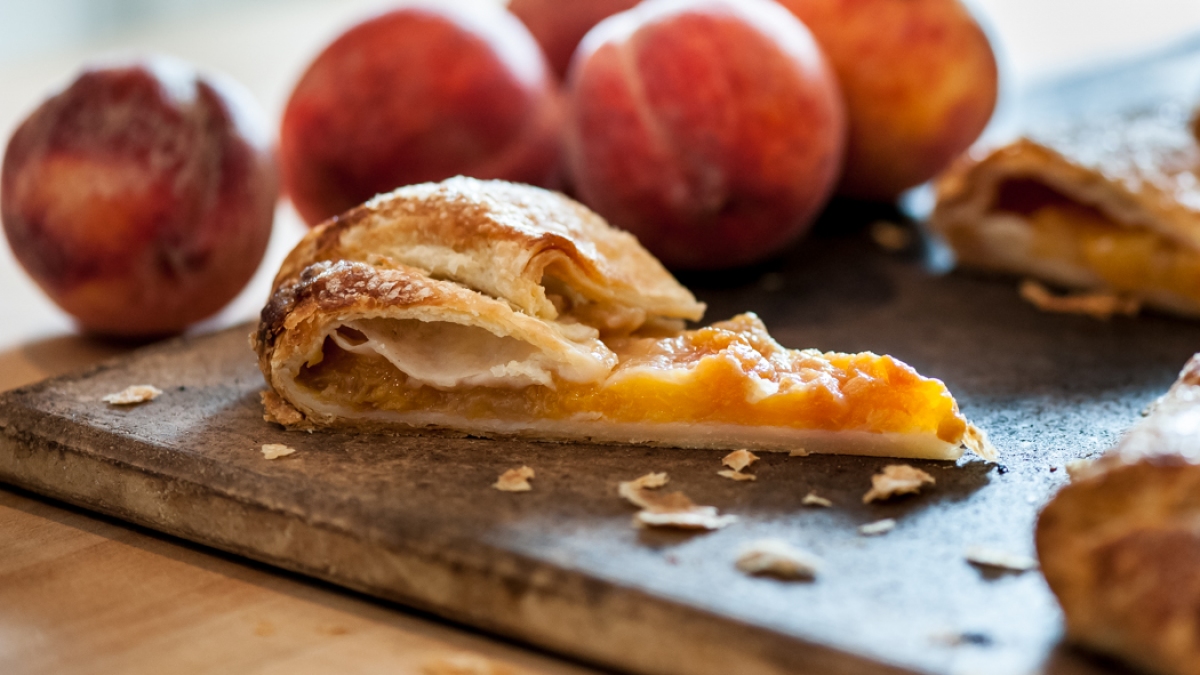
Star Anise & Espresso Macarons with Pear Cinnamon Jelly – Gluten-Free
February 24, 2016
Anise & Espresso Macaron with Pear, and Cinnamon Jelly combines the elegance and sophistication this macaron deserves. Crispy anise flavoured meringue shells filled with creamy coffee and spice transform the everyday into something remarkable. Pear and Cinnamon Jelly lighten the earthy anise, and espresso flavour. When served in the afternoon, or after a meal, they will satisfy even the most discriminating palate.
For anyone who bakes, the components of this Star Anise & Espresso Macarons with Pear Cinnamon Jelly will be familiar: an almond flour Italian meringue, jelly and a buttercream filling. Essentially simple, The Finer Cookie will show you how to finesse the macaron batter to the correct consistency–a consistency that will produce the classic foot that every macaron should have. Homemade macarons are like nothing you’ve ever had before. You will be duly rewarded.
Please consult The Finer Cookie’s How-To post on How to Whip Egg Whites for more details.
This recipe has been adapted from Thomas Keller’s Bouchon Bakery. For further details on the reference, please see the end of this page.
The Finer Cookie is a participant in the Amazon Services LLC Associates Program, an affiliate advertising program designed to provide a means for websites to earn advertising fees by advertising and linking to amazon.com. This post contains affiliate links, which means The Finer Cookie will receive a small commission if you make a purchase using this link. This modest income helps support the website.
Ingredients
Macaron Ingredients
- 1 3/4 cups +2 1/2 tablespoons 212 grams 7.5 ounces almond flour
- 1 3/4 cups + 1 tbsp 212 grams 7.5 ounces powdered sugar
- 1/4 cup + 1 1/2 tablespoons egg whites 82 grams 2.9 ounces egg whites, room temperature
- 1/4 cup + 2 tablespoons egg whites 90 grams 3.2 ounces egg whites, room temperature
- 1 cup + 3 tablespoons 236 grams 8.3 ounces granulated sugar
- ⅔ cup 158 grams 5.5 ounces water
- 1 tablespoon 1 tablespoon 1 tablespoon sambuca, pernod or other anise flavoured liquor
- 1/2 teaspoon 1/2 teaspoon 1/2 teaspoon anise oil
Pear Cinnamon Jelly
- 3/4 sheet 1.8 grams 3/4 sheet silver leaf gelatine or 1 packet of knox gelatin
- 3 tablespoons 3 tablespoons 3 tablespoons water
- 1 medium 1 medium 1 medium unpeeled pear, cut in half and cored.
- 2 whole 2 whole 2 whole cinnamon sticks
- 2 tablespoons 2 tablespoons 2 tablespoons brown sugar
- 2 cups 256 grams 16 ouncess water
- 2 pinches 2 pinches 2 pinches fine salt
Espresso Buttercream Ingredients
- 3 tablespoons + 1/2 tsp 38 grams 1.3 ounces granulated white sugar
- 3 tablespoons + 1/2 tsp 38 grams 1.3 ounces granulated white sugar
- 1/4 cup + 1/2 tsp 63 grams 2.2 ounces egg yolks
- 1/4 cup + 2 1/4 75 grams 2.6 ounces whole milk
- 8.8 ounces 250 grams 8.8 ounces unsalted butter, at room temperature, cut into ½-inch cubes
- 1 vanilla bean 1 vanilla bean 1 vanilla bean
- 3/4 to 1 teaspoon 3/4 to 1 teaspoon 3/4 to 1 teaspoon espresso powder

Instructions
MISE EN PLACE FOR THE MACARON
- To see how Mise en Place can benefit you, see The Finer Cookie’s post on why everyone should Mise en Place.
- Measure almond flour and powdered sugar in the bowl of a food processor and pulse to a very fine powder.
- Sift the flour/sugar mixture into a wide bowl. This is an important step because the heat from the food processor could clump the mixture. In order to get a consistent meringue, you don’t want clumps.
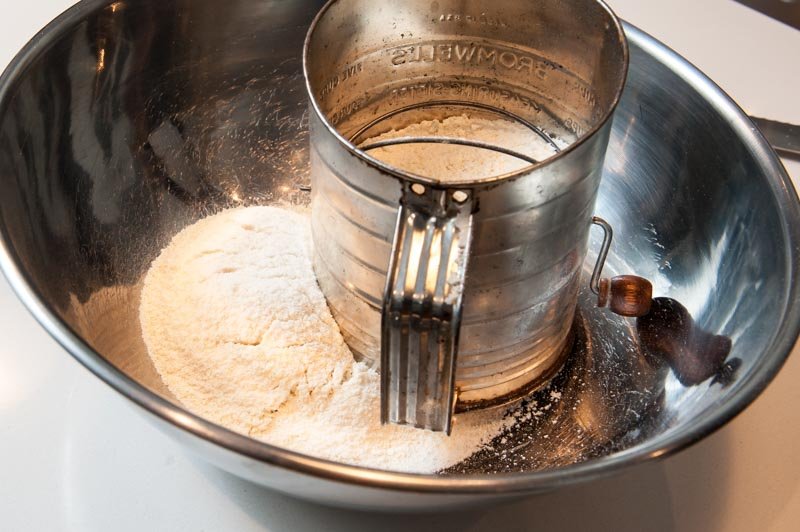
- Make a well in the center of the sifted mixture, leaving a layer of flour on the bottom of the bowl.
- Weigh 90 grams of egg whites into one bowl and 82 grams of egg whites into a separate bowl.
- Set aside the bowl with 90 grams of egg whites.
- In a small saucepan, weigh sugar and water.
- Line the two trays with parchment. With the long edge facing you, draw 4 circles along the top edge of the paper, spacing them about an inch apart. For the second row, trace three circles spacing them between the first circles. Then trace 4 circles for the third row and 3 circles for the fourth row. You will have 14 circles in total on each sheet.
- Lightly spray the trays with cooking spray and flip the paper over (ink side down), and adhere the parchment. This will keep the parchment flat during baking.
- Ready your thermometer.
- Ready your piping bag with 1/2 inch round tip.
- Ready the Sambuca and anise oil

MAKING THE MERINGUE
- Turn the heat to low and stir to dissolve the sugar and water.
- Stir constantly until the mixture is clear and the sugar is no longer visible. Stop stirring and raise the heat.
- When the syrup has reached 203F degrees, reduce the heat.

- Pour 90 grams of egg whites into the bowl of your stand mixer.
- Set the speed to medium low, breaking up the mass of egg whites. Slowly increase the speed to medium high. Whip the egg whites to soft peaks. Please consult The Finer Cookie’s How to Whip Egg Whites for more details.
- Return to the sugar syrup, and increase the heat. Without stirring, heat the syrup to 248??F degrees. As soon as it reaches temperature, turn the mixer on the Stir setting.
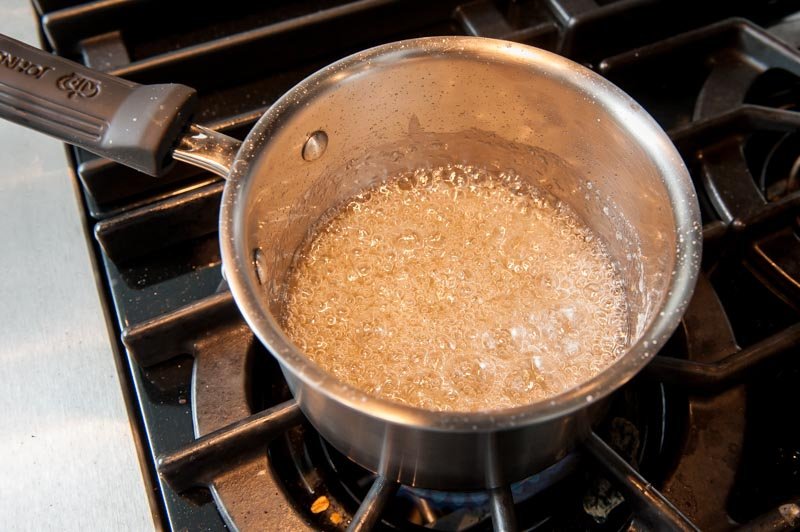
- Slowly pour the hot syrup between the whisk and the side of the bowl, being careful not to let the hot sugar touch the whisk.
- Once the meringue and the syrup are incorporated, increase the speed to medium-high. The egg whites will increase in volume and let off a lot of steam.
- Let the mixer run for approximately 5 minutes to cool the meringue.
- Add the Sambuca and anise oil.

- After 5 minutes, the bottom of the bowl will still be warm, but the meringue will be cool, not cold.
- Keep in mind, that as the sugar cools, the meringue will become stiffer. You want the meringue to remain flexible, and not stiff.

- While the meringue is cooling with the mixer running, pour 82 grams of egg whites into the large bowl with the flour/sugar mixture.
- Stir until all the dry ingredients are moistened and incorporated.
- The mixture will be very stiff, but this is the correct texture.


- Once the whipped meringue has cooled, add about one third to the almond/sugar paste and with a firm spatula, combine well so that the paste loosens. Be thorough at this stage.
- Add meringue in several additions to the paste mixture.
- The next step is a make-or-break moment.

CRITICAL STEP FOR SUCCESSFUL MACARONS
- It is at this point, you want the meringue to deflate, be shiny, and pour off your spatula into thick ribbons that dissolve into itself very slowly. You are looking for a specific consistency that takes a few minutes to develop. As you slowly fold the batter, it will loosen a little at a time. You will be wondering: “Am I there yet?” If you’re asking, you’re probably not. As you fold the batter, it will continue to be thick, but will become smoother. As it loosens, it won’t hang on to your spatula. It will flow off your spatula in thick ribbons without melting into itself too fast. Time yourself in one minute intervals. If after a minute, the batter dissolves into itself, it’s ready. It usually takes me about 3 minutes to get the right consistency. It is possible to go past the optimum texture. If you do, the batter will be a bit runny and pour through the pastry tip. It won’t hold its ribbon when piped and will be hard to control. It’ll melt into itself too quickly. When properly mixed, the baked macarons will be thick enough the pipe easily; and when baked, they will have a little foot at the base where the eggs have risen. Each foot should be the same thickness on each baked cookie.
UNDERSTANDING THE MACARON
- The more intact the egg white foam/meringue, the more rise you will get on the cookie and the more cracking will occur in the shell because of the rising. In other words, if you are making a soufflé, you would want very little deflation because you want it to rise. For the macaron, you want the meringue to deflate because the cookie is supposed to rise only a little bit, but not enough to crack or distort it. The finished cookie will be on the thin side.
PIPING THE MERINGUES
- When you feel you’ve arrived at the right texture, fit a large pastry bagwith a 1/2 plain round tip and fill it with batter. The macaron batter won’t run out the tip, but it will be very easy to pipe.
- Holding the bag perpendicular, pipe out enough batter to just fill the circle.

- The batter will gentle spread the entire diameter of the circle and the nipple left by the tip will melt away. It’s important to hold the bag straight up and down and not off to the side because the batter will settle lopsided and won’t bake unevenly.
- Keep count as you pipe, and use the same count for each circle.

- When the meringues are piped, let them rest for at least 15 minutes. You will see the meringue settle out, become smoother and shinier, and the nipple left by the piping bag should melt away. Remember that the batter will spread as it settles, so be careful not to pipe too much batter into each circle, or add batter to those that don’t have enough.
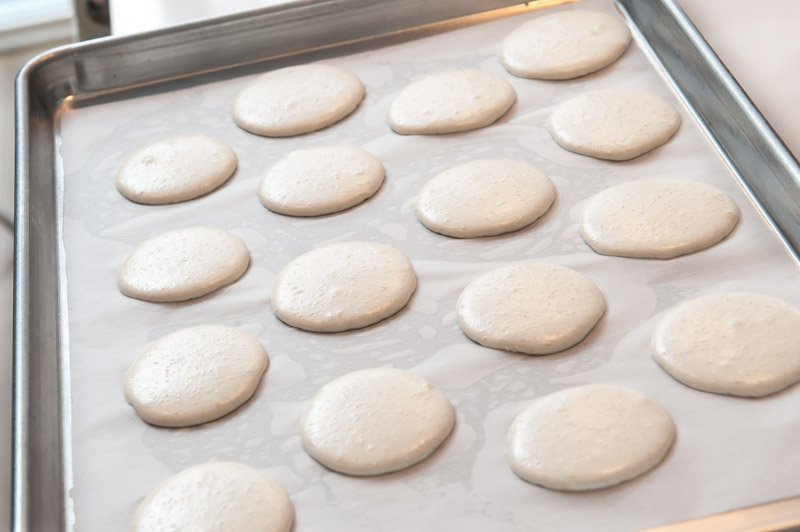
BAKE THE MERINGUES
- Preheat the oven to 300F, but not hotter than 325F. If you’re using the convection setting, adjust the heat accordingly. Bake anywhere from 8-15 minutes. They are done when the shell is set and the tops are smooth and shiny.
- If you can bake one tray at a time in the lower to middle of the oven. Avoid the top rack as the temperature could be too hot.
- Let trays cool on a wire rack, and then peel the cookies off the paper and let cool completely.
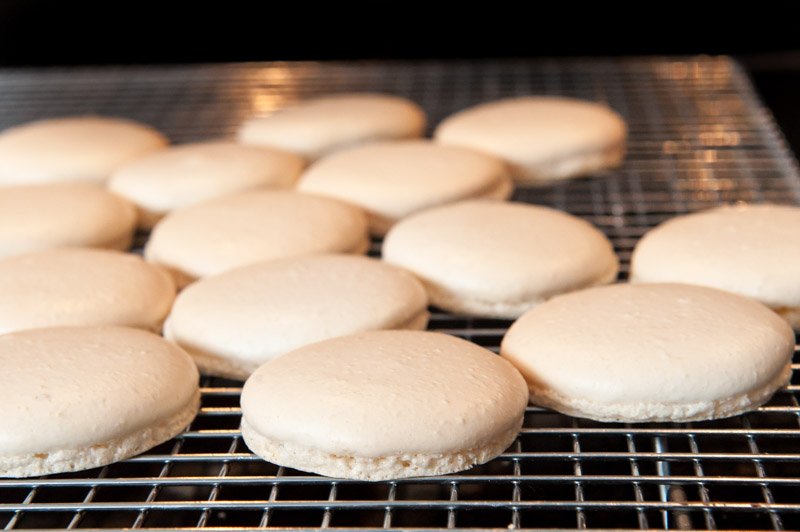
MISE EN PLACE PEAR, CINNAMON JELLY
- If you are using powdered gelatine, bloom it by sprinkling it over 3 tbsp water. Let it sit for 5 minutes until the gelatine is swollen with moisture.
- Core and cut the pear in chunks.
- Combine the pear, brown sugar, water and salt in a saucepan.
COOK THE PEAR, CINNAMON JELLY
- Bring the mixture to a simmer and cook for about 30-45 minutes, until the pear is very soft and the liquid is infused with the flavour of cinnamon and has reduced to about 1.5 cups. Add either the bloomed gelatine or the sheet and stir until it’s dissolved.
- Puree the mixture in either a food processor or a blender.
- Let cool and refrigerate until set.
MISE EN PLACE FOR THE ESPRESSO BUTTERCREAM
- Whisk 38 grams of sugar, espresso powder, and the egg yolks and set aside.
- Combine milk, vanilla bean and remaining 38 grams of sugar in a medium saucepan and set aside.
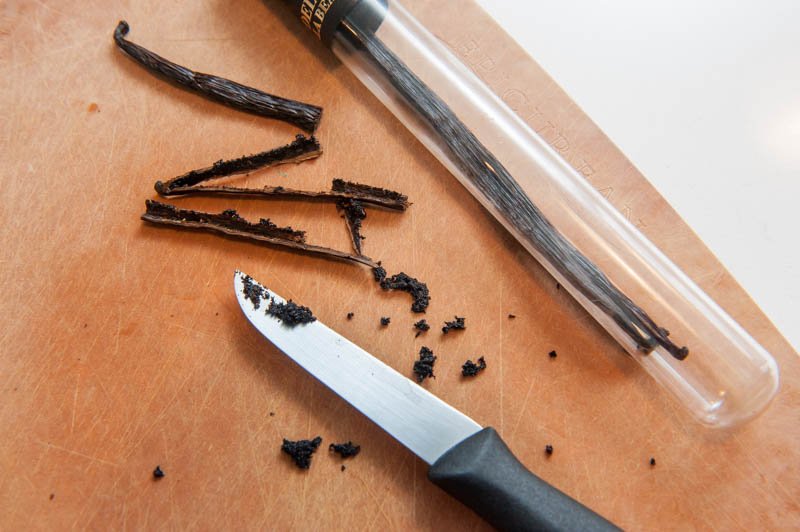
- Measure the softened, room temperature butter and set aside

- Ready an instant thermometer, fine mesh strainer, and a stand mixture with a whisk attachment.
MAKING THE CUSTARD FOR THE ESPRESSO BUTTERCREAM
- Set the milk, vanilla bean and sugar over medium heat and stir until the sugar is dissolved.
- Raise the heat until tiny bubbles form along the rim of the saucepan and steam starts to rise.

- By the tablespoon full, add the hot milk mixture to the egg yolks and whisk vigorously. Do this repeatedly, adding a little more each time until all the hot milk is incorporated into the egg yolks. This is called tempering the egg yolks.
- Pour the egg yolk mixture back into the original saucepan and set the heat to medium. With a flat tipped spatula, stir continuously, keeping constant contact with the bottom of the saucepan. You want to keep the whole mixture moving to prevent the egg yolk from settling to the bottom and curdling.
- Stir until steam begins to rise off the surface and you feel it thicken. Continue cooking until the temperature reaches 175 degrees F.
- Remove from the heat and strain the custard into the bowl of the stand mixer.
- Fit the mixer with a whisk attachment and turn the mixer to medium.
- Whisk for about 8 minutes or until the custard is completely cool.
- NOTE: If the custard is even a little warm when you add the butter, the butter will melt and create a soup. You don’t want that so take you time to ensure the custard has really cooled.
MAKING THE ESPRESSO BUTTERCREAM
- Once the custard has cooled, slowly add the softened butter piece by piece, ensuring that it is incorporated after each addition. If at any point the mixture looks broken, it is likely the butter is too cold, then increase the speed to re-emulsify it, then continue to add the butter. If the buttercream is too loose to hold its shape, then the buttercream is too warm, so refrigerate it for 10-15 minutes, and beat again until it is the proper consistency.
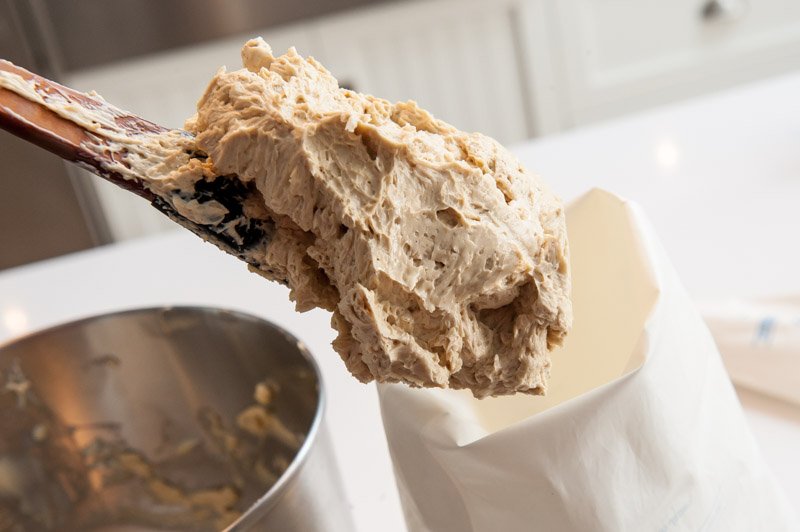
FILL THE MACARON MISE EN PLACE
- Fit one large bag with a 1/2 inch tip and fill with the buttercream
- Stir the set jelly vigorously to break up and soften the mixture.
- Pair up the macaron cookies, turning half of them over
ASSEMBLING THE MACARONS
- Holding the large bag perpendicular, pipe the buttercream just inside the edge of the cookie, leaving the center empty.
- Repeat with the turned over cookies.

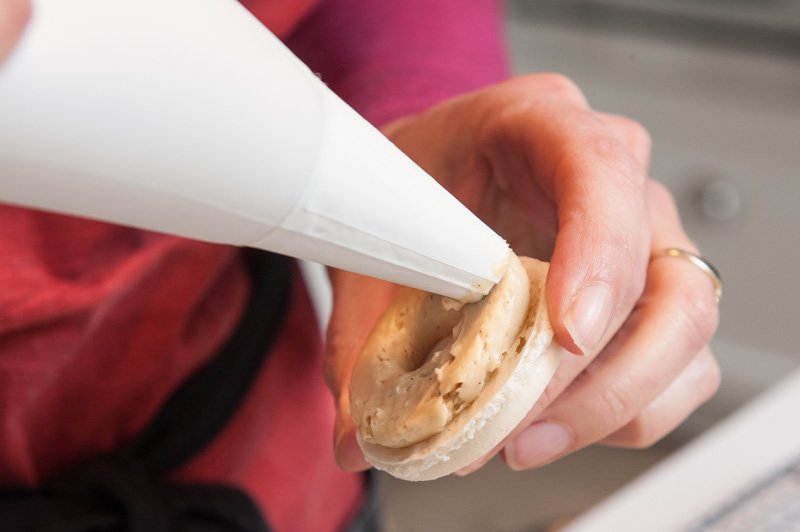

MAKING THE MACARON SANDWICHES
- Very carefully put the second cookie over the filling, twisting very gently. The risk here is that the cookie could crack as you are pressing them together.
- Twisting it slightly prevents cracking and evens out the filling.
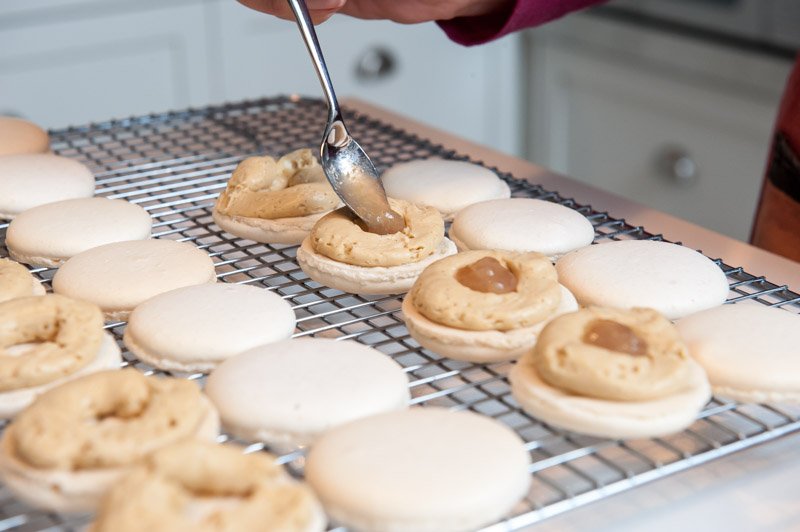
FLAVOUR MATURATION FOR THE MACARON
- The flavor at this point will be good, but will be better after sitting in the freezer for 24 hours. Before freezing, place the tray in the fridge for a few hours until the buttercream is firm. Then wrap each cookie individually in plastic, being careful not to crack the delicate macaron. Freeze for 24 hours or more. After a stint in the cold, the flavor will mature and reach its peak. Don’t let them sit too long, or they will lose the flavour intensity.

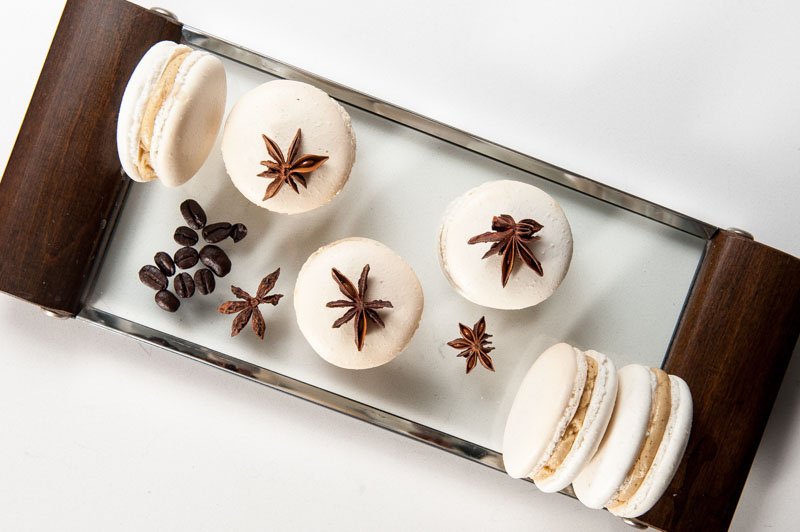
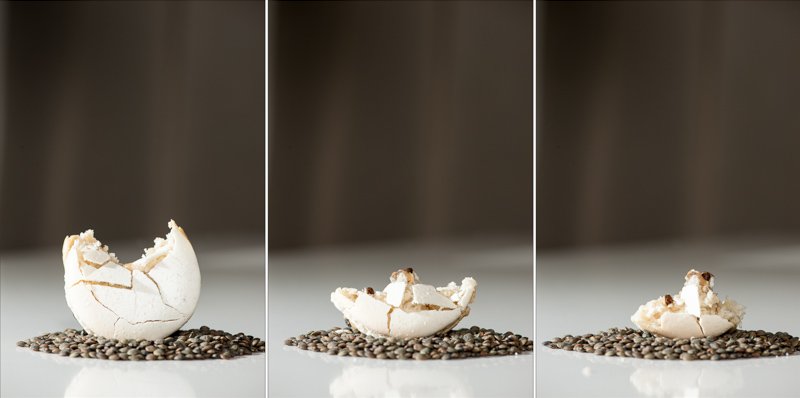
- For more information about this recipe, please consult the following reference: Keller, Thomas and Sebastien Rouxel. “Macarons”, Bouchon Bakery. New York, NY: Artisan, 2012. Pages 58-65. Also see this online reference from American Almond: http://www.americanalmond.com/pdfs/AllAboutParisianMacarons.pdf. It is a very comprehensive and reliable source.
- Labels
- Gluten Free,
- Low Sugar,
- Savoury
